Northeast Italy
Northeast Italy
| |
|---|---|
 | |
| Country | Italy |
| Regions |
|
| Area | |
| • Total | 62,310 km2 (24,060 sq mi) |
| Population Emilian-Romagnol | |
Northeast Italy (
Historical names
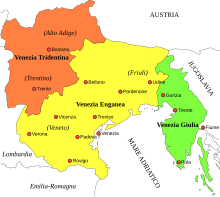
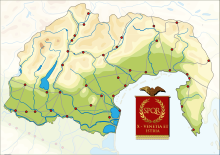
Geography
It borders to the north with Austria and Switzerland, to the east with Slovenia, to the south with Liguria, Tuscany, Marche and the small state of San Marino, to the west with Lombardy and for a very short stretch with Piedmont. Emilia-Romagna, Friuli-Venezia Giulia and Veneto are washed by the Adriatic Sea
Northeastern Italy includes most of the
Demography
In 2022, the population resident in north-eastern Italy amounts to 11,532,690 inhabitants.[1]
Regions
| Region | Capital | Inhabitants |
|---|---|---|
| Bologna | 4,426,929 | |
| Trieste | 1,192,191 | |
| Trento | 1,075,317 | |
| Venice | 4,838,253 |
Most populous municipalities
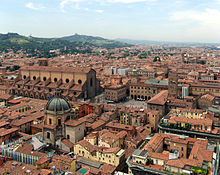
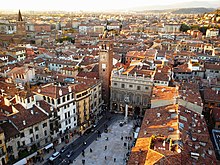

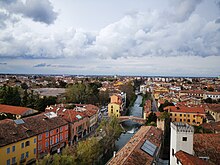
Below is the list of the population residing in 2022 in municipalities with more than 50,000 inhabitants.[1]
| # | Municipality | Region | Inhabitants |
|---|---|---|---|
| 1 | Bologna | 398,971 | |
| 2 | Verona | 255,588 | |
| 3 | Venice | 250,369 | |
| 4 | Padua | 206,496 | |
| 5 | Trieste | 198,417 | |
| 6 | Parma | 196,764 | |
| 7 | Modena | 184,153 | |
| 8 | Reggio Emilia | 169,545 | |
| 9 | Ravenna | 155,751 | |
| 10 | Rimini | 149,211 | |
| 11 | Ferrara | 129,340 | |
| 12 | Trento | 118,046 | |
| 13 | Forlì | 116,440 | |
| 14 | Vicenza | 109,823 | |
| 15 | Bolzano | 106,107 | |
| 16 | Piacenza | 102,465 | |
| 17 | Udine | 97,808 | |
| 18 | Cesena | 95,778 | |
| 19 | Treviso | 84,607 | |
| 20 | Carpi | 71,869 | |
| 21 | Imola | 69,121 | |
| 22 | Faenza | 58,710 | |
| 23 | Pordenone | 51,725 |
Languages
Economy
The Gross domestic product (GDP) of the region was 407.9 billion euros in 2018, accounting for 23.1% of Italy's economic output. GDP per capita adjusted for purchasing power was 34,900 euros or 116% of the EU27 average in the same year.[9]
See also
- National Institute of Statistics (Italy)
- NUTS statistical regions of Italy
- Italian NUTS level 1 regions:
- Northern Italy
- Central Italy
- Southern Italy
References
- ^ a b c "Bilancio demografico e popolazione residente per sesso al 31 dicembre 2022" (in Italian). Retrieved 29 July 2023.
- ^ "Legge 482". Webcitation.org. Archived from the original on 24 September 2015. Retrieved 2015-10-17.
- ^ Venetia
- ^ Peace of Prague (1866)
- ^ Treaty of Saint-Germain-en-Laye (1919)
- Treaty of Peace with Italy, 1947
- JSTOR 43767660. Retrieved 14 January 2021.
- ^ Berto, Luigi (2013). ""Venetia (Venice)": Its Formation and Meaning in the Middle Ages" (PDF). NeMLA Italian Studies. 35: 1–2. Retrieved 14 January 2021.
- ^ "Regional GDP per capita ranged from 30% to 263% of the EU average in 2018". Eurostat.
